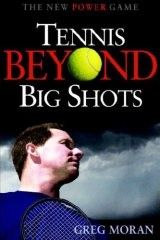October 2006 Article
Mortal Tennis/Circle Game Archive
Tennis Server
|

 |
This month I'd like to take a look at a small area of the doubles court that can cause big problems for recreational players: the alleys. Though a small target visually (54 inches wide) a drive down the alley can be as tempting to the club player as an extra scoop of ice cream. One of the things I notice, as I work with doubles players, is that many do not have a true understanding of when to and when not to attempt a shot down their opponent's alley. Point after point, game after game, they'll attempt to drill the ball down their opponent's alley, only to be frustrated by their own errors or an easily put away volley by an alert net player. In doubles there are three scenarios in which you would try to hit the ball down your opponent's alley: if they fail to cover it, if they're actively poaching, or if they volley poorly. Let's take a look at each.
In the first scenario, players at the 4.0 level and above will move as they're supposed to which means that if your opponent hits out wide to you, the opposing net player, ninety-nine percent of the time, will shift to cover his alley. If you then try to drive the ball down their alley they'll have a huge smile on their face as they easily put away the volley down the middle of your court, between you and your partner. In the second scenario, strong players usually like the net and volley well which means that if you hit down their alley they will, again, be quite happy to put your shot away either between you and your opponent or right at your partner's feet. That leaves you with only one true scenario in which you should be attempting to drive the ball down your opponent's alley: if he or she is actively poaching. At the 4.0 level you will more often than not be faced with a net player who is skilled and aggressive in their movements. As you prepare to receive serve, they'll be bouncing up and down, feinting left and right and, on occasion, shooting across the court in an attempt to pick off your return. They'll be doing anything they can to distract you as you prepare to hit your shot and guess what? That's exactly what they're supposed to do. That's tennis at the upper levels. Your response to their active (and usually quite annoying) movement is to drive the occasional shot down their alley. When I play, I almost always attempt an alley shot in the first game of the match for no other reason than to show my opponents that I can, and will, hit there. Even if I give away an early point, the message I've sent to my opponent's makes them think twice before they poach. So there you have it, if you're playing the game at the 4.0 level and above, your trips down the alley should be far and few between. Remember, in good doubles the vast majority of your points will be won by hitting the ball down the middle of the court, at your opponent's feet or over their heads. Stay away from the alleys and you'll see your errors decrease and your number of doubles wins increase. Suggested viewing How great was this year's U.S. Open? Agassi's final matches, Martina's Grand Slam winning farewell and the return of Jimmy Connors to the game. In addition to helping Andy Roddick reach the finals, Connors was out at the Open each day signing copies of his new six set DVD series titled Jimmy Connors Presents: Tennis Fundamentals." A fun watch, Connors gathers a star-studded lineup that includes Chris Evert, Tracy Austin, James Blake and Justine Henin-Hardenne to take recreational players through the fundamentals of the game. One of my all-time favorites, I must say that it's great to see Connors (looking very fit after hip replacement surgery) back in the game.
This column is copyrighted by Greg Moran, all rights reserved.
Greg Moran is the Head Professional at the Four Seasons Racquet Club in Wilton, Connecticut. He is a former ranked junior and college player and certified by both the USPTA and USPTR. Greg has written on a wide variety of tennis-related subjects for numerous newspapers and tennis publications including Tennis, Tennis Match and Court Time magazines. He is also a member of the FILA and WILSON Advisory Staffs.
Questions and comments about these columns can be directed to Greg by using this form.
|



October 2022 Tennis Anyone: Patterns in Doubles by John Mills. September 2022 Tennis Anyone: Short Court by John Mills. |

 You will join 13,000 other subscribers in receiving news of updates to the Tennis Server along with monthly tennis tips from tennis pro Tom Veneziano.
You will join 13,000 other subscribers in receiving news of updates to the Tennis Server along with monthly tennis tips from tennis pro Tom Veneziano. 